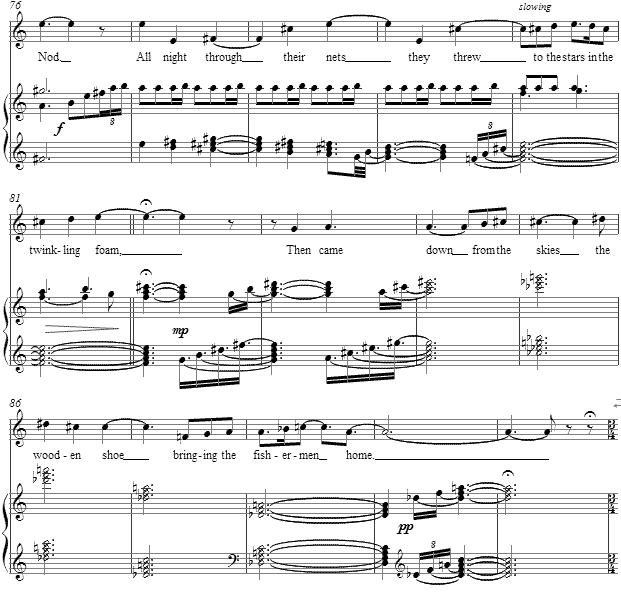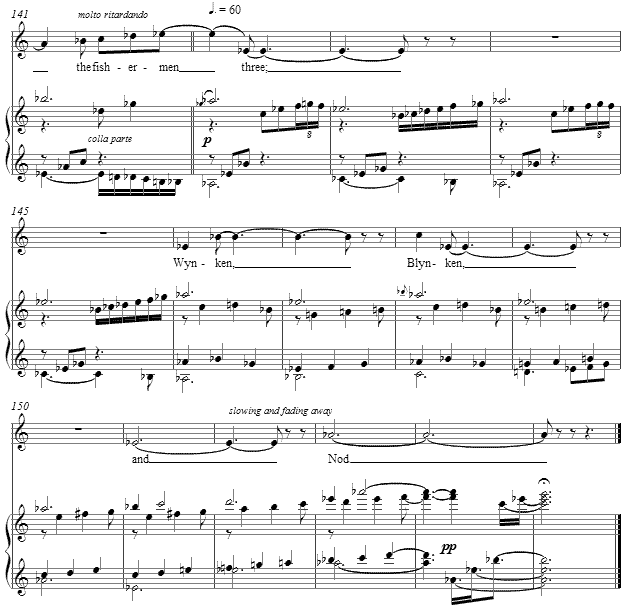Music and Texts of GARY BACHLUND
Vocal Music | Piano | Organ | Chamber Music | Orchestral | Articles and Commentary | Poems and Stories | Miscellany | FAQs
Wynken, Blynken, and Nod - (2007)
Eugene Field
for medium high voice and piano
Wynken, Blynken and Nod one night
Sailed off in a wooden shoe--
Sailed on a river of crystal light
Into a sea of dew.
"Where are you going and what do you wish?"
The old moon asked the three.
"We have come to fish for the herring fish
That live in this beautiful sea;
Nets of silver and gold have we!"
Said Wynken,
Blynken,
And Nod.
The old moon laughed and sang a song,
As they rocked in the wooden shoe,
And the wind that sped them all night long
Ruffled the waves of dew.
The little stars were the herring fish
That lived in that beautiful sea--
"Now cast your nets wherever you wish--
Never afeard are we!"
So cried the stars to the fishermen three:
Wynken,
Blynken,
and Nod.
All night long their nets they threw
To the stars in the twinkling foam.
Then down from the skies came the wooden shoe,
Bringing the fishermen home.
'Twas all so pretty a sail it seemed
As if it could not be
And some folks thought 'twas a dream they'd dreamed
Of sailing that beautiful sea--
But I shall name you the fishermen three:
Wynken,
Blynken,
and Nod.
Wynken and Blynken are two little eyes,
And Nod is a little head,
And the wooden shoe that sailed the skies
Is a wee one's trundle bed.
So shut your eyes while mother sings
Of wonderful sights that be,
And you shall see the beautiful things
As you rock in the misty sea,
Where the old shoe rocked the fishermen three:
Wynken,
Blynken,
and Nod.[ 8 pages, circa 4' 50" ]
Eugene Field
Born in St. Louis, Missouri, and raised in Amherst, Massachusetts, Eugene Field was an American writer, best known for his children's poetry and humorous essays. He attended Williams College in Massachusetts, then Knox College in Galesburg, Illinois but dropped out, and then went to the University of Missouri. He tried acting and studied law with little success. He then set off for a trip through Europe but returned to the United States six months later, penniless. Field then set to work as a journalist for the Gazette in Saint Joseph, Missouri in 1875, and later rose to become its city editor. When first at the Gazette, he married Julia Comstock, with whom he had eight children. For the rest of his life he arranged for all the money he earned to be sent to his wife, saying that he had no head for money himself. He was well known for his light, humorous articles written in a gossipy style, some of which were reprinted by other newspapers around the country.
From 1876 through 1880 Field lived in St. Louis, first as an editorial writer for the Morning Journal and subsequently for the Times-Journal. After a brief stint as managing editor of the Kansas City Times, he worked for two years as editor of the Denver Tribune. In 1883 Field moved to Chicago where he wrote a humorous newspaper column called Sharps & Flats for the Chicago Daily News.
He first started publishing poetry in 1879, when his book Christian Treasures appeared. Over a dozen more volumes followed and he became well known for his light-hearted poems for children, perhaps the most famous of which is "Wynken, Blynken, and Nod". Several of his poems were set to music with commercial success. Many of his works were accompanied by paintings from the American artist, Maxfield Parrish. Field has his own star on the St. Louis Walk of Fame. Numerous elementary schools throughout the Midwest are named for him.
The setting of this poem wanders through several tonal domains, by the broad use of whole tone, polytonal and chromatic gestures. As with our own dreams which can meld many images together, this unease at resting in any tonal domain is a musical reflection of that penchant of the human mind. While the setting's first strophe hovers around A major and minor, this is not a necessary indication of what is to come.
The third stanza of the poem begins asymmetrically over bridge material, rather than with another strophe of the song. Again, the melodic line reflects a tonal domain of A while the harmonic underpinning leads in a differing direction.
The ending of this musical setting slips down from the beginning hint at A minor, into a solid A flat, with inner voices leading through whole tone changes as the harmonic rhythm and tempo of the work lessens to a final cadence, as if "falling asleep."
The score to Wynken, Blynken and Nod is available as a free PDF download, though any major commercial performance or recording of the work is prohibited without prior arrangement with the composer. Click on the graphic below for this piano-vocal score.



